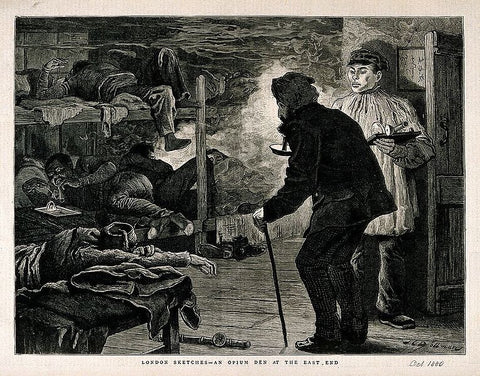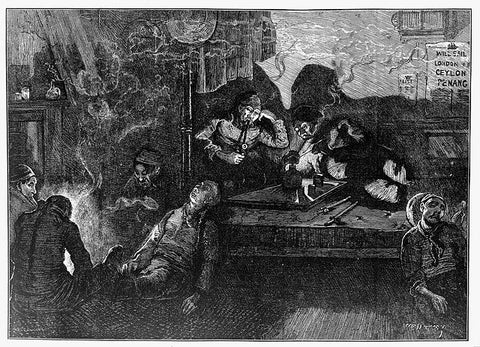
"Through the gloom one could dimly catch a glimpse of bodies lying in strange fantastic poses, bowed shoulders, bent knees, heads thrown back, and chins pointing upward, with here and there a dark, lack-lustre eye turned upon the newcomer. Out of the black shadows there glimmered little red circles of light, now bright, now faint, as the burning poison waxed or waned in the bowls of the metal pipes. The most lay silent, but some muttered to themselves, and others talked together in a strange, low, monotonous voice, their conversation coming in gushes, and then suddenly tailing off into silence, each mumbling out his own thoughts and paying little heed to the words of his neighbour. ... As I entered, a sallow Malay attendant had hurried up with a pipe for me and a supply of the drug, beckoning me to an empty berth." (-from The Man with the Twisted Lip; The Adventures of Sherlock Holmes by Arthur Conan Doyle)
This small paragraph in the Adventures of Sherlock Holmes describes one of the popular images we have of opium dens. Author Doyle was not the only one that described opium dens as part of a darker side of Victorian London; Oscar Wilde and Charles Dickens described these dangerous places run by mysterious Oriental people as well in their books. Even newspapers in European cities gleefully described the city of London as the sensationalist and sinister center of a sprawling network of opium dens.
However, in reality opium dens weren’t nearly as widespread in London (they were in France though) or as mysterious as these popular stories tell us. In Victorian times laudanum, an derivative of opium, and other opiates were easily available in chemist’s shops and used as a common medicine for a great range of illnesses. So how come that the Chinese were the evil instigators of addicting people to opium? Why are mysterious opium dens such a prevailing stereotypical image, even nowadays in movies and TV shows?
A LITTLE BIT OF HISTORY
Let us start 300 years ago. England and the Chinese Qing Empire were engaged in some pretty difficult trade relations. The English imported tea, silk, porcelain and other items from China. China, in return, was actually pretty much self-sufficient and only interested in some English silver. With their silver supply rapidly dwindling (because the English have a love affair with tea), they went looking for something else the Chinese would be interested in in trading. And in their Bengal colonies they found opium.
Opium had been known in China for at least a thousand years, but the drug was hard to get by and was only used as medicine by the elites. This changed when the English started supplying tonnes of opium every year and with the invention of vaporising opium, instead of eating it or mixing it with tobacco. The use of opium recreationally became immediately a widespread social problem. The Qing Emperor tried banning and outlawing the trade and use of opium, but to no avail. There were millions of opium users in China and for England the trade was far too lucrative to stop.

China’s efforts to ban opium started the Opium Wars in the middle of the 19th century. However, China was defeated and humiliated in both wars. The results of these wars were a big decline of power of the Qing Emperor, a flourishing and forced legalised opium trade, ransacking and burning of the royal Summer Palaces by Anglo-French troops, and Hong Kong becoming a British colony.

China was forced to open its borders for trade. This led to the grow of Chinatowns and Chinese communities abroad. For example, the greatest number of Chinese immigrants came to the USA to work on the railroads or tried to find their fortune during the Gold Rush.
Of course, with the influx of Chinese workers in the 19th century came their social habit of opium smoking and opium dens. Most opium dens were run and frequented by the Chinese and were situated near where the Chinese lived and worked. But also French seamen and expatriates brought back the habit of opium smoking from their own colonies in Indochina. Opium smoking acquired a mysterious image due to the exotic-looking immigrants and romanticised tales brought back from far-flung colonies.

THE OPIUM DEN
Opium kits were cumbersome and too big to carry around and addicts often wanted a private spot to smoke so a den was the place to go.
There was a big difference in the smoking of opium between the elite members of societies and poorer workers. The very rich often had a private smoking room in their own house and a servant who prepared the opium for them. Opium dens catered to all layers of society, but differed highly in furnishings and attendants. High-end opium dens had elaborate beds, intricately carved opium kits and many female attendants who prepared the pipes. In cheap opium dens, smokers lay on a mat or shared beds and brought their own kits. Often attendants helped to prepare the pipes because the preparation of opium for vaporisation was a bit difficult. These lower-end establishments catered more often to foreigners than high-end ones.
Opium smokers lay on their side while preparing and smoking opium. An opium kit consisted of a tray, a pipe, an opium box, a lamp and utensils to prepare the opium. If they were rich enough, they laid down on a bed that provide quiet and privacy as opium users were sensitive for loud noises and stress. An opium bed had three raised sides that ensured there was no draft to stir the flame of the opium lamp and interrupt the smoking.
They rested their head on a hard, thick pillow. An opium pillow was often made from wood, leather or porcelain. Wooden and leather pillows were rectangular and looked like simple neck supports while the porcelain ones had elaborate designs. Pillows in the shapes of cats, angels or even babies were quite popular. Even though porcelain is hard, after a few smokes from the opium pipe the smoker would feel like their head was laying on a cloud. The cool porcelain would have been a nice relief for the heated skin. Square ceramic opium pillows were produced in China and often exported to commercial opium dens in overseas Chinese communities in North America or Europe. One end is often decorated, the other end has an opening where the smoker could store his wallet. Once all valuable items were inside, the aperture side was pushed against the wall while the head rested on the pillow. This way valuables were stored safely while the owner was intoxicated.
Opium pipes were made in many kinds of materials and in elaborate or simple designs. Apparently smokers had personal opinions on the best taste of opium with pipes made of certain materials.
OPIUM ANTIQUITIES
But British authorities did know about opium addiction and its dangers to society, even though they continued their opium trade in the East. Money trumped morals, at least until they started to worry about opium’s evils affecting their own people. They tried to contain opium smoking by issuing ethnic restrictions on its use so the white population was not contaminated by the habit. Because of the low status of Chinese and Indian immigrants, their habits and opium dens were portrayed in the media as places of vice, deadly overdoses, violence and gambling which could corrupt the white population. These portrayals sketched London as the hotbed of opium smoking in Europe, which was almost a complete fantasy written to scandalise the Victorian population and polarise opinions on ‘yellow peril’. To scare people away from opium abuse, European and American authorities enforced a full ban on opium. Crackdowns ensued and the social habit of smoking opium fell into decline.
LEFTOVER HISTORY
Nowadays, it is very hard to find an original opium pipe or opium kit. An enormous amount of opium kits were destroyed during crackdowns on addiction in the West and in China. What remains of opium smoking are mostly old, private opium kits brought from Indochinese colonies, the furnishings of dens, like beds and pillows, and romanticised tales and horror stories of this oriental habit.
These small and often overlooked items do carry a lot of history. We did not find any decorative opium pipes or kits on our travels, but we found some very cool opium pillows. For course, nobody is interested now in an unyielding earthenware pillow, but they still make very cool decorative accents in an interior. We prefer to use them as candlelight holders or potpourri pots! This way, any modern interior can carry a bit of the unique history of the opium dens!
- February 23, 2017
- Margret Ressang

